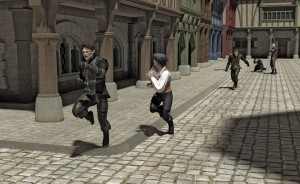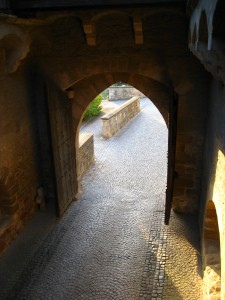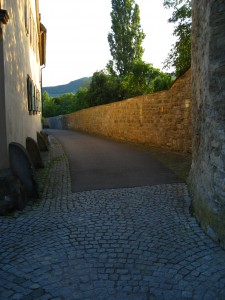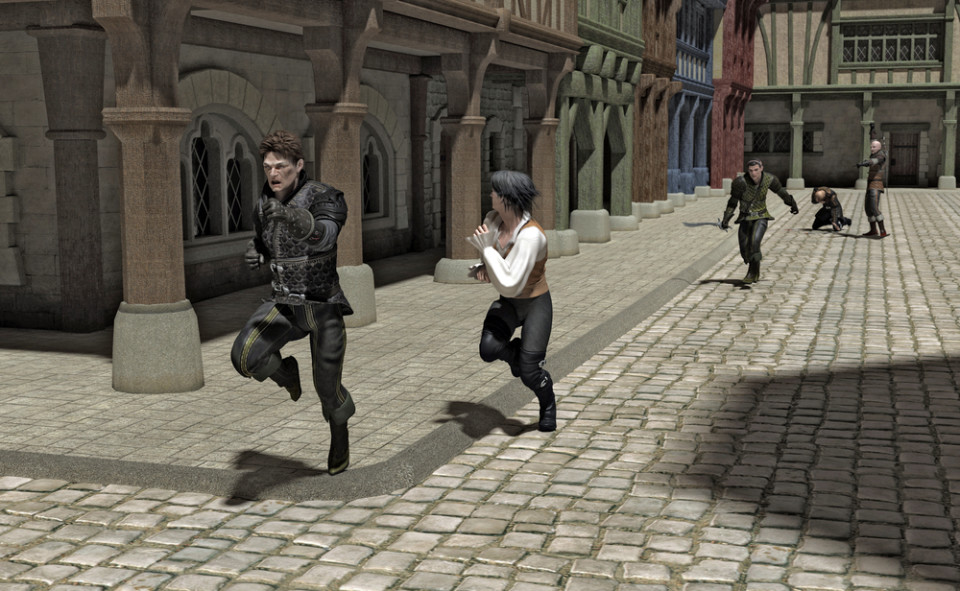
Stop! Thief!
Cries pierce the night air and echo down the narrow streets. Doors and shutters fly open, feet pound the cobblestone, and the pursuit begins. A criminal has struck in a European town, and the residents respond in the only way they know how. They are raising the hue and cry.
Before the advent of professional police, citizens helped catch the crooks. Everyone knew what to do. If you were the witness or victim of a crime, you cried out. Anyone hearing the hue and cry had to dash out onto the streets to chase and catch the culprit. Townsfolk made a citizen’s arrest and waited for a sheriff to arrive and haul away the suspect.
Hue and cry in England
The hue and cry probably had its origins in Germany, where towns continued to use it well into the 17th century. In England, Æthelstan codified it as early as the 10th century. In 1285, the Statute of Winchester required bystanders to respond to the hue or face a fine. The system not only empowered communities to protect themselves, it ensured there would be witnesses. Any witness who didn’t raise the hue became suspect. In 1329, for instance, John Brayn witnessed a homicide in Northhamptonshire but failed to summon help with the hue and cry. He was imprisoned.
Hue and cry in continental Europe
People used the hue and cry throughout England and continental Europe. What the victim cried out depended on the country.
- In Germany, victims initiated the hue by calling out “Zeter und Mordio!”
- In France, a victim hollered “haro,” “harou,” or “harue.”
- Italians yelled “accor’uomo!” and Hungarians “Tolvaj!” (thief) or “Tulai!” (help).
- In England, it was usually “thief,” “fire,” or “wolf,” depending on the situation. Shepherds used the latter, and crying wolf when no wolf is there amounts to nothing more than abuse of the hue and cry.
- Other countries, like Spain, also used the hue and cry too, although I haven’t found exactly what words the Spaniards used.

Role of city walls in the hue and cry
Besides the fleeing thief, pursuing townsfolk, and sheriff, a forth factor played a role in the hue and cry, and it was one that made it uniquely European and especially effective. The city walls trapped the thief so he or she couldn’t get very far. Towns had only a handful of exits at the city gates, and if the citizens raised the hue, the watchmen would slam the gates shut. Trapping the criminal made the chase easier.

The city walls did more to facilitate this medieval law enforcement method than just contain the suspect. Historian Emise Bálint pointed out that because of the medieval city’s layout, the hue and cry worked better. Buildings and walls better carried the ringing echoes of the cry through the streets and alleys. Houses were built bordering the streets, and without trees and shrubbery to absorb the sounds, residents could better hear a cry for help. People also lived closer together and were more likely to hear someone hollering.
Changes in city structure and improved law enforcement mean that the hue and cry is rarely used today. But it still occurs: Stories of victims crying out for help and a modern-day heroes chasing down crooks still grace our newspapers today.
The National Archives in the United Kingdom has an interesting website and game dealing with the hue.
Can you offer a modern example of this old law enforcement technique?
Literature on point
Emise Bálint, Mechanisms of the Hue and Cry in Kolozsvár in the Second Half of the Sixteenth Century, in Cultural History of Early Modern European Streets (Ledien, Bosten: Brill 2009) pp. 39-62.
Janka Rodziewicz, “Women and the Hue and Cry in Late Fourteenth-Century Great Yarmouth,” in Women, Agency and the Law, 1300-1700 (Abingdon: Routledge, 2013) 15:87-98.
Samantha Sagui, “The hue and cry in medieval English towns,” Historical Research 87(236):179-193 (2014).




In Spain we should cry “ladrón”/robber! but ‘in Spain we don’t do that’:
I did have an instance when a Moroccan stole my purse descending to the subway station in the middle of Madrid and a cool summer evening in 2002.
He lifted my purse by my shoulder strap and began to run off. My 75 year old companion grabbed the purse in a flash and returned it to me. With that the robber lost his shoe.
I retrieved the shoe. Everyone on all four sides of stairs descending to the station stopped.
I looked at the robber who was praying that I return the shoe and I exclaimed in Spanish, “in Spain we don’t do that.” and threw the shoe back to him. He caught it ran as fast as he could into the night.
The 200 spectators, at least, applauded my companion and the lady in the ticket office gave him a thumbs up!
Having used Madrid’s subway system last year, I can well imagine what the scene you just described looked like. I wonder what would have happened if you had cried out “ladrón!” If other people in the subway station had chased and caught the robber, it would have been a modern example of the hue and cry.
Either way, your 75-year-old companion was a hero for reacting so quickly and saving your purse. Fourteen years later, here in Germany, I’m applauding him too. Thanks for sharing your story, Susan!